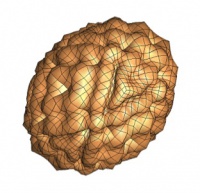Contents |
fall 14 - me334 - mechanics of the brain
|
me 337 - mechanics of the brain 14 ellen kuhl fall 2014 |
goals
Our brain is not only our softest, but also our least well-understood organ. Floating in the cerebrospinal fluid, embedded in the skull, it is almost perfectly isolated from its mechanical environment. Not surprisingly, most brain research focuses on the electrical rather than the mechanical characteristics of brain tissue. Recent studies suggest though, that the mechanical environment plays an important role in modulating brain function. Neuromechanics has traditionally focused on the extremely fast time scales associated with dynamic phenomena on the order of seconds or milliseconds. The prototype example is traumatic brain injury where extreme loading rates cause intracranial damage associated with a temporary or permanent loss of function. Neurodevelopment, on the contrary, falls into the slow time scales associated with quasi-static phenomena on the order of weeks or months. A typical example that has recently received growing attention is cortical folding, where compressive forces between the gray matter layer and the white matter substrate cause structural instabilities and induce surface buckling. We begin this course by dissecting mammalian brains to explore their neuroanatomy and neuromorphology and correlate our observations to neurophysiology. We discuss morphological abnormalities including lissencephaly and polymicrogyria and their similarities with neurological disorders including schizophrenia and autism. We address the role of mechanics during brachycephaly, plagiocephaly, tumor growth, and hydrocephalus. We close with the fast time scales and explore the mechanics of traumatic brain injury with special applications to shaken baby syndrome.
grading
- 20 % dissection - presentation and written report, 10% each
- 30 % homework - three homework assignments, 10% each
- 20 % project presentation - graded by the class
- 30 % project report - graded by instructor
syllabus
| day | date | topic | slides | homework | |
|---|---|---|---|---|---|
| tue | sep | 23 | introduction to brain anatomy | s01 | |
| thu | sep | 25 | introduction to brain mechanics | s02 | |
| tue | sep | 30 | dissecting brains | s03 | |
| thu | oct | 02 | brain anatomy - student presentations | s04 | |
| tue | oct | 07 | brain mechanics in 1d – elasticity of neurons | s05 | |
| thu | oct | 09 | brain mechanics in 3d – elasticity of the brain | s06 | |
| tue | oct | 14 | brain mechanics in 3d – viscoelasticity of the brain | s07 | |
| thu | oct | 16 | brain mechancis in 3d – poroelasticity of the brain | s08 | |
| tue | oct | 21 | brain growth in 1d – axonal growth | s09 | |
| thu | oct | 23 | brain growth in 2d – morphogenesis | s10 | |
| tue | oct | 28 | brain growth in 3d – physiology and pathology | s11 | |
| thu | oct | 30 | brain growth in 3d – pathologies | s12 | |
| tue | nov | 04 | brain growth in 3d – brain tumors | s13 | |
| thu | nov | 06 | brain fluid mechanics – hydrocephalus | s14 | |
| tue | nov | 11 | brain dynamics in 1d - axonal injury | s15 | |
| thu | nov | 13 | neurosurgery - brain doctors | s16 | |
| tue | nov | 18 | brain dynamics in 3d - traumatic brain injury | s17 | |
| thu | nov | 20 | brain dynamics in 3d – shaken baby syndrome | s18 | |
| tue | dec | 02 | final projects - discussion, presentation, evaluation | s19 | |
| thu | dec | 04 | final projects - discussion, presentation, evaluation | s20 | |
| fri | dec | 05 | final project reports due |
matlab files
finally... here's the matlab code for brain folding
additional reading
(1) taber l. biomechanics of growth, remodeling, and morphogenesis, appl mech rew 48, 487-545, 1995
(2) kuhl e, menzel a, steinmann p. computational modeling of growth - a critical review, a classification and two new consistent approaches, computational mechanics 32, 71-88, 2003
(3) rodriguez ek, hoger a, mc culloch a. stress-dependent finite growth in soft elastic tissues, j biomechanics 27, 455-467, 1994
(4) kuhl e, maas r, himpel g, menzel a. computational modeling of arterial wall growth - attempts towards patient-specific simulations based on computer tomography, biomech model mechanobio 6, 321-331, 2007
(5) göktepe s, abilez oj, parker kk, kuhl e. a multiscale model for eccentric and concentric cardiac growth
through sarcomerogenesis.j theor bio 265: 433-442, 2010
(6) ambrosi d, ateshian ga, arruda em, cowin sc, dumais j, goriely a, holzapfel ga, humphrey jd, kemkemer r, kuhl e, olberding je, taber la, garikipati k. perspectives on biological growth and remodeling.j mech phys solids 59: 863-883, 2011
(7)
zöllner am, buganza tepole A, kuhl e. on the biomechanics and mechanobiology of growing skin. j theor bio 297, 166-175, 2012
(8) menzel a, kuhl e. frontiers in growth and remodeling. mech res comm 42,1-14, 2012

